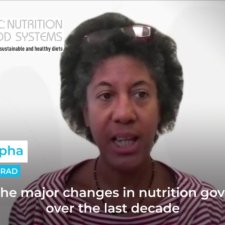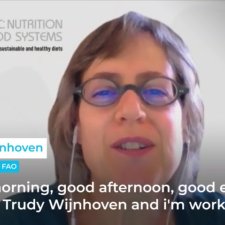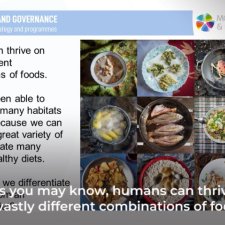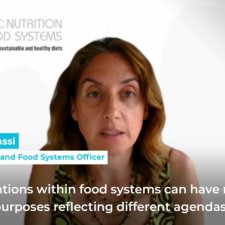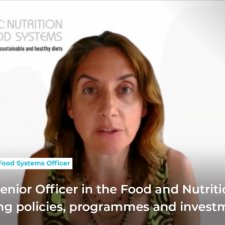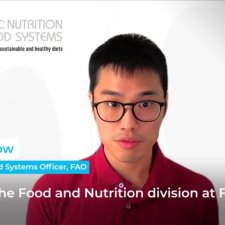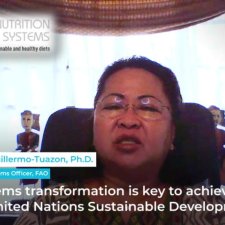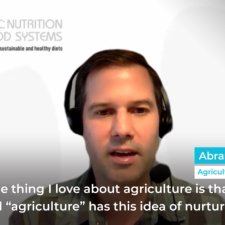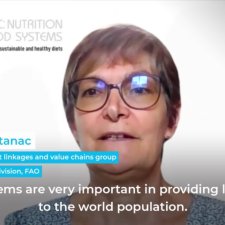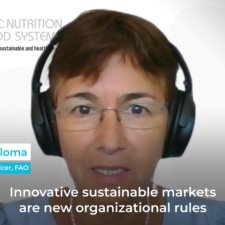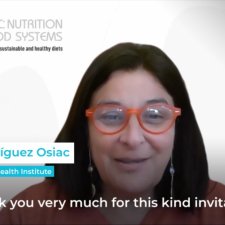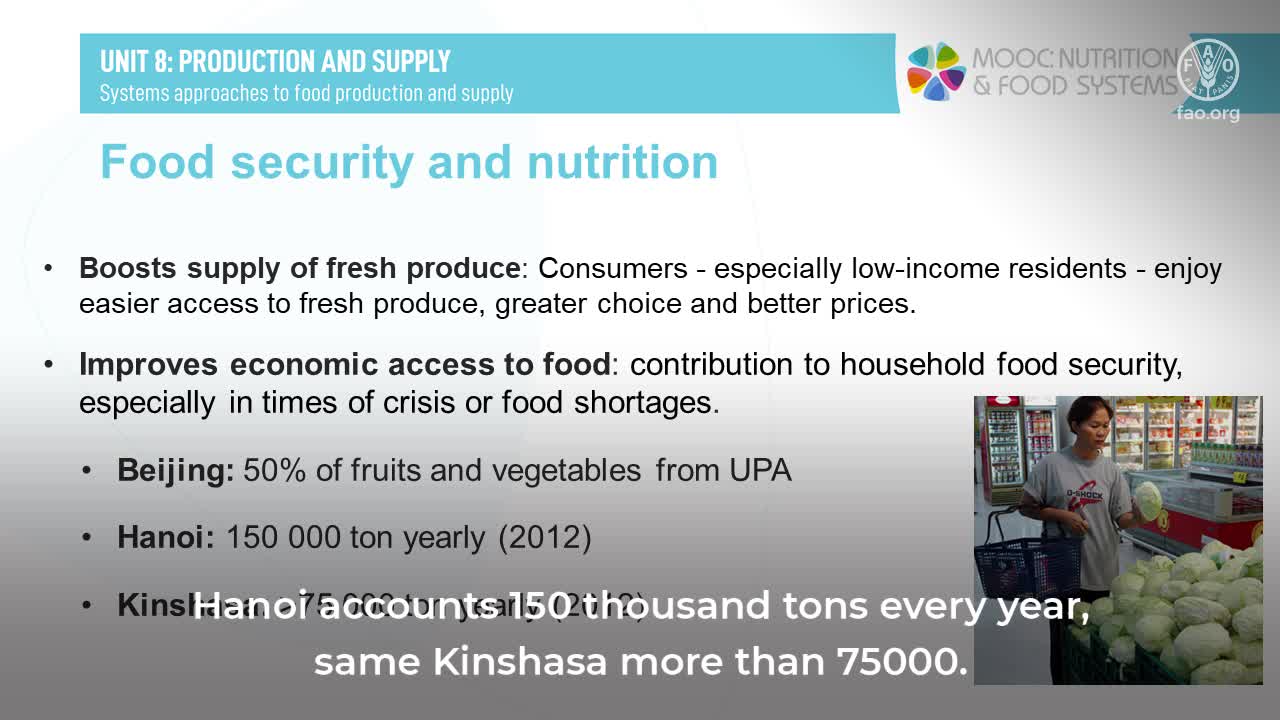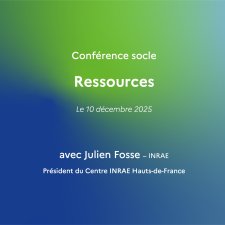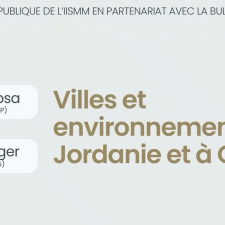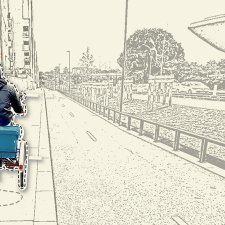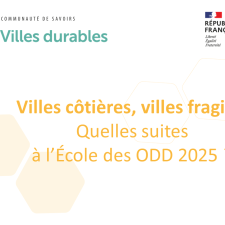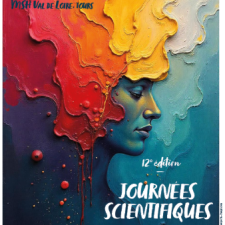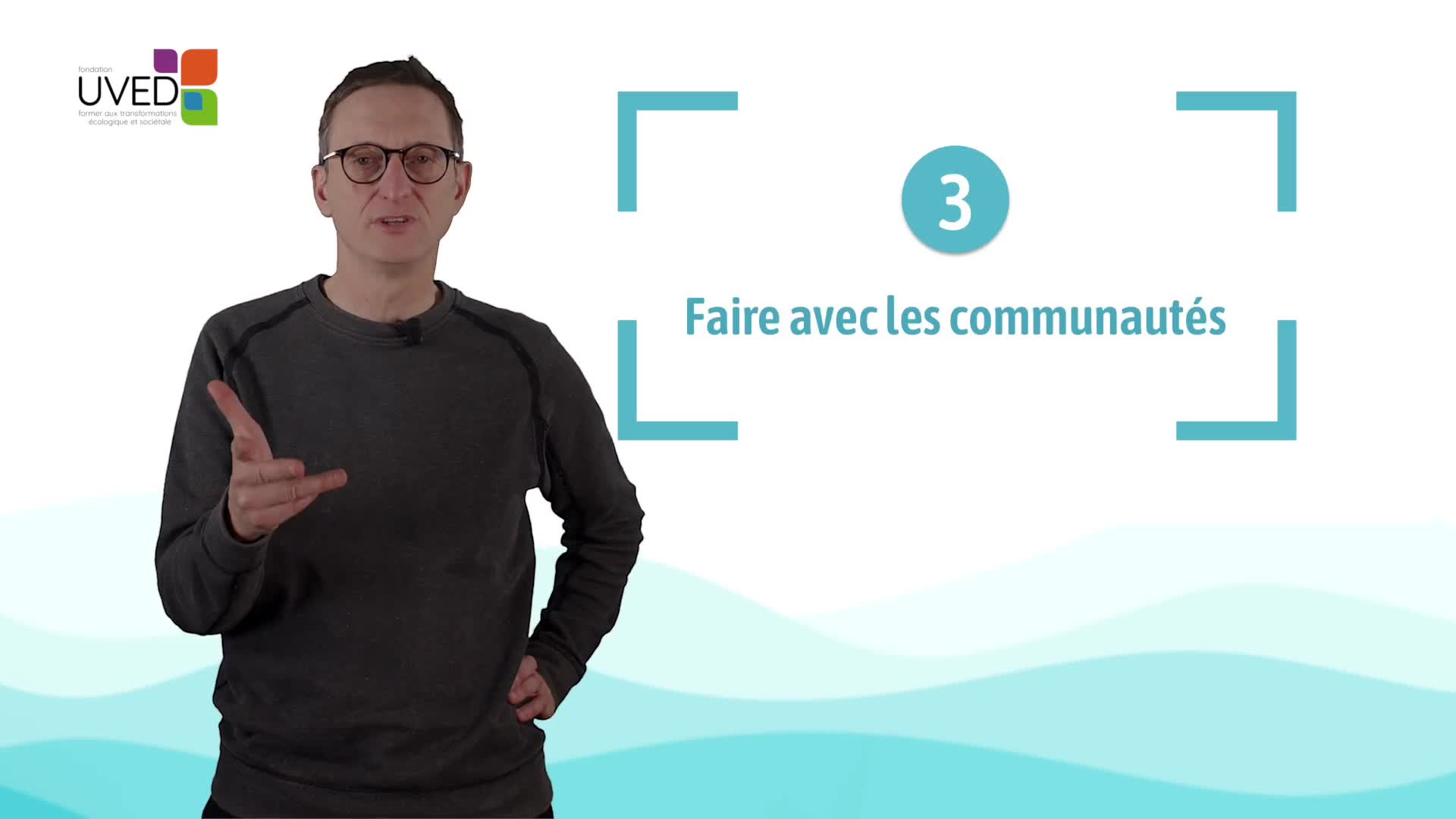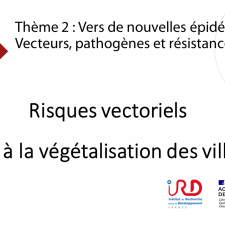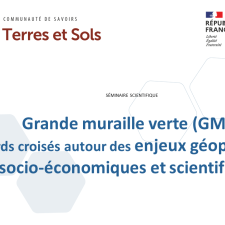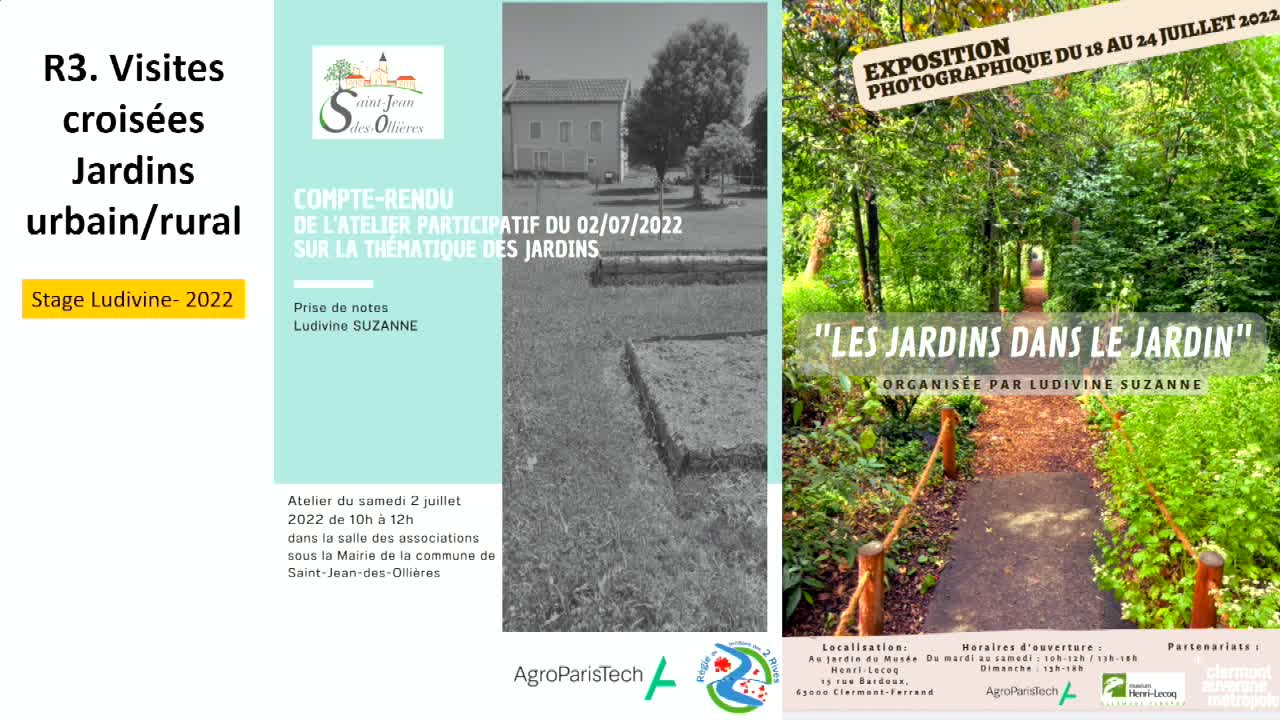Notice
The role of urban and periurban agriculture in promoting sustainable food systems
- document 1 document 2 document 3
- niveau 1 niveau 2 niveau 3
Descriptif
Guido Santini (Programme Coordinator, FAO) develops a presentation on the role of urban and periurban agriculture in promoting sustainable food systems in urban areas : overview of the challenges that cities are facing in recent times; how urban agriculture can play a role in reinforcing food systems and building resiliency.
Current and rapid urbanization impacts food security and national resources, but also diets, through increased consumption of highly processed food and animal proteins food.
Guido Santini demonstrates why it is crucial to promote Green Cities, integrating aspects of Food Security and Nutrition, resilience, economic development, environmental sustainability, and social inclusion; and why urban and periurban agriculture can be a driver to promote more sustainable cities, as well as nutrition education. He shows also the role that urban and periurban agriculture play for employment, livelihoods and households economy, and in environmental issues.
Despite all these advantages, a number of challenges remain to get them fully recognised and promoted: urban agriculture should be part of an urban and territorial planning and linked to other food system dimensions.
Intervention / Responsable scientifique
Dans la même collection
-
Lessons for food system policy, programs and governance – A word from the experts
AlphaArlèneBhattacharjeeLalitaInterview with Arlène Alpha (Researcher, CIRAD) and Lalita Bhattacharjee (Senior Nutrition Advisor, FAO Bangladesh) about food system policy, programs and governance.
-
United Nations Decade of Action on Nutrition 2016–2025
WijnhovenTrudyTrudy Wijnhoven (Nutrition Officer, FAO) gives presentation about the United Nations Decade of Action on Nutrition 2016–2025, also referred to as the Nutrition Decade.
-
Food-based dietary guidelines (FBDGs) to inform policies and programmes for food system transforma…
Islas RamosAnaAna Islas Ramos (Nutrition Officer, FAO) spoke about the use of FBDGs to inform policies and programmes to transform food systems.
-
Lessons for food system policy, programs and governance
FracassiPatriziaPatrizia Fracassi (Senior Nutrition and Food System Officer, FAO) explains (and gives examples) that interventions within the food systems can have competing priorities that require balancing risks
-
From data to impact – Tools for gathering information and taking decisions. A word from the experts.
Guillermo-TuazonMaria AntoniaVan DoorenCornéInterview with Maria Antonia Guillermo-Tuazon (Nutrition and Food Systems Officer, FAO) and Corné van Dooren (World Wildlife Fund Netherlands).
-
Nutrition-sensitive investment in agriculture and food systems - Budget analysis guidance note
FracassiPatriziaPatrizia Fracassi (Senior Nutrition and Food System Officer, FAO) presents FAO’s work on Budget Analysis for nutrition sensitive investments in agri-food systems.
-
The theory of change in programming for sustainable healthy diets - Understanding the system thinki…
SeowTi KianLorvaoClémentTi Kian Seow (Nutrition and Food Systems Officer, FAO) and Clement Lorvao (Senior Monitoring and Evaluation Expert, FAO) present how to use theories of change and impact pathways to mainstream
-
From data to impact – Tools for gathering information and taking decisions
Guillermo-TuazonMaria AntoniaMaria Antonia Tuazon (Nutrition and Food Systems Officer, FAO) addressed the issue of data collection for planning, monitoring and evaluating the transformation of food systems.
-
Systems approaches to food production and supply – a word from the experts
BickslerAbramPolo GalanteAndreaInterview with Abram Bicksler (Agricultural Officer, FAO) and Andrea Polo Galante, (Senior Nutrition Consultant, FAO) on linkages between healthy diets and food production and the sustainable food
-
Systems approaches to food production and supply
TartanacFlorenceFlorence Tartanac (Senior officer, market linkages and value chains groups, FAO) looks at the definition of food systems and their role in providing a fair livelihood for the world's population.
-
Systems approaches to the food environment - A word from the experts
MattioniDaliaSantacolomaPilarInterview with Dalia Mattioni, Research Associate - FOODTRAILS project - School of Geography and Planning, Cardiff University) and Pilar Santacoloma, Agri-food Systems Officer, FAO, who explain how
-
Systems approaches to the food environment Law on food labelling and advertising: the Chilean exper…
Rodríguez OsiacLorenaDra. Lorena Rodríguez Osiac (Professor, Public Health Institute, University of Chile) presents the experience implemented in Chile on food labelling and advertising.
Avec les mêmes intervenants et intervenantes
-
Le rôle de l'agriculture urbaine et périurbaine dans la promotion de systèmes alimentaires durables
SantiniGuidoGuido Santini (coordinateur de programme, FAO), présente le rôle de l'agriculture urbaine et périurbaine dans la promotion de systèmes alimentaires durables dans les zones urbaines.
Sur le même thème
-
Ressources
FosseJulienConférence socle du parcours transition écologique des hauts fonctionnaires et cadres supérieurs d'État sur la thématique du climat
-
Villes et environnement en Jordanie et à Oman
AbabsaMyriamKlingerThibautBilardelloSophieConférence publique de l’Institut d’études de l’Islam et des sociétés du monde musulman (IISMM) en partenariat avec la Bibliothèque universitaire des langues et civilisations (BULAC).
-
Là où je suis, là où je vais : du temps de l’école au monde du travail, une histoire de transitions
BrossaisEmmanuelleCapdevielleValérieChevallier-RodriguesEmilieCourtinatAmélieLeonardisMyriam deSavourninFlorenceAu travers du suivi de trois jeunes à différents moments de leur parcours – Benjamin ou le temps scolaire, Quentin et le monde du travail, Adrien vers une autonomie – ce documentaire est l’occasion de
-
Villes côtières, villes fragiles : Quelles suites à l’École des ODD 2025 ? - CoSavez-vous ? Villes …
Après les sessions de l’Ecole des ODD 2025 consacrées aux villes côtières , ce webinaire poursuit les échanges très riches pour faire émerger de nouveaux questionnements aux croisements entre des
-
Du pot aux recettes : expérimentation de préparations gauloises, romaines, médiévales et modernes,…
Roure-HorardMarie-PierreNous disposons, sur de nombreux sites archéologiques, de céramiques à usage culinaire gauloises, romaines, médiévales et modernes dont les argiles ont enregistré, par imprégnation, les marqueurs
-
Les zones littorales face au changement climatique : une approche culturelle
RicherJeanJean Richer, chercheur au laboratoire PoLiCEMIES de La Rochelle Université, propose dans cette vidéo une lecture culturelle de l'adaptation au changement climatique dans les zones littorales.
-
Voix aux chapitres #6 : Autour de l'ouvrage "La Chine par le menu"
HuretRomainKiesowRainer MariaSabbanFrançoiseFournierTristanTrémonAnne-ChristineStanzianiAlessandroThéryAëlLa sixième séance de Voix aux chapitres est consacrée à l'ouvrage La Chine par le menu. Cuisine culture culinaire et traditions alimentaires chinoises de Françoise Sabban, 12 décembre 2024 à l'EHESS.
-
Risques vectoriels liés à la végétalisation des villes
FournetFlorenceFlorence Fournet rappelle l’urbanisation croissante dans le monde et ses impacts négatifs. Elle présente les bénéfices sur la santé humaine de la végétalisation des villes, ainsi que des menaces
-
Grande muraille verte : Regards croisés autour des enjeux géopolitiques, socio-économiques et scien…
L’Initiative de la Grande muraille verte vise à apporter des solutions à grande échelle pour inverser durablement la dégradation des terres de 11 pays du Sahara et du Sahel. Cette initiative suscite
-
Regards croisés sur le séisme de 557 à Byzance : histoire, archéologie, sismologie [ép. 1/2]
Pour la rentrée de la saison 2024-2025, nous vous emmenons dans la Byzance du VIe siècle ap. J.-C., non pour admirer les ors des palais et le galbe des coupoles, mais pour vivre avec sa population
-
Véganes ou cannibales : le casse-tête des alimentations néandertaliennes
JaouenKlerviaDepuis quelques années, les analyses isotopiques nouvellement mises au point ont permis d'explorer en profondeur l'alimentation néandertalienne, révélant des informations précieuses sur leur régime
-
HORTUS - Revaloriser les jardins potagers pour une résilience des territoires
LardonSylvieSylvie Lardon (UMR Territoires) présente le projet HORTUS qui vise à revaloriser les jardins potagers sur le territoire du projet alimentaire territorial (PAT) du Grand Clermont et du PNR Livradois


